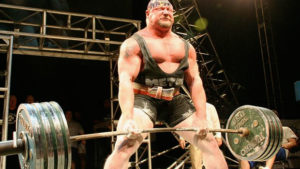The deadlift is considered by many to be the king of lifts, and it’s easy to see why-you either pick it up off the ground and stand up tall, or you don’t. There isn’t a question about depth like there is in the squat, and it’s generally loaded much heavier than the bench press. It certainly won’t make a balanced program by itself, but it’s a good starting point for most strength plans. If you want to work towards a bigger deadlift here are a few tips that should help you out.
Don’t Wear Tennis Shoes
Since you’re pulling the bar off the floor, it’s advantageous to minimize the distance you have to pull as much as possible, and tennis shoes are often thick and have a heel lift, meaning you’ve increased the distance the bar has to travel. So, no shoes or Chuck’s are best for your deadlift day. An added benefit of lifting barefoot or in Chuck’s instead of tennis shoes is that it will be easier for you to put force into the floor. Tennis shoes are soft and it’s more difficult to produce force on a soft surface because you have the added demand of stabilizing yourself (think about jumping out of sand instead of off the gym floor).
Set Up Faster
I see a lot of lifters taking their time in the bottom position, grabbing the bar and tinkering with their set-up. When you’re ready to lift, set your feet, brace hard, take a big breath in, and then grab the bar and go! By setting up fast you’ll be able to take advantage of the stretch shortening cycle and and this may help you move more weight. A word of caution on this-it’s not for beginners. Beginners need to groove their set-up, and doing it as fast as possible will make this difficult. Also, as a beginner you’ll make progress pretty quickly just by getting some reps under you belt, so no need to try anything special.
Do Heavy Hip Thrusts
A lot of lifters struggle with locking out their hips at the top of a deadlift. They need to get stronger through end range hip extension, and heavy hip thrusts are a great way to do that. The glutes are primarily responsible for end range hip extension, and they can be an overlooked part of many training programs. Lifters assume that by squatting and deadlifting they’re getting plenty of glute work, but many of them are not. Bret Contreras has repeatedly shown that there is greater glute activation during the hip thrust than the squat or deadlift. During the hip thrust, the hamstrings are shortened more than the squat or deadlift because the knees are flexed (bent) and the hips are extended simultaneously, both of which shorten the hamstrings, creating active insufficiency. This means the hamstrings can’t produce enough force to get the hips to end range extension due to how much they’ve been shortened, so the glutes have to help more.
Try these tips out and shoot me an email with any training inquiries!
Resources
Photo:
“How-to-improve-deadlift-grip.jpg” by Deadlift Asylum CC BY-SA 4.0
References
Contreras, Bret. “Hip Thrust and Glute Science.” bretcontreras.com, 6 April, 2013, https://bretcontreras.com/hip-thrust-and-glute-science/

